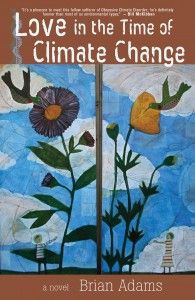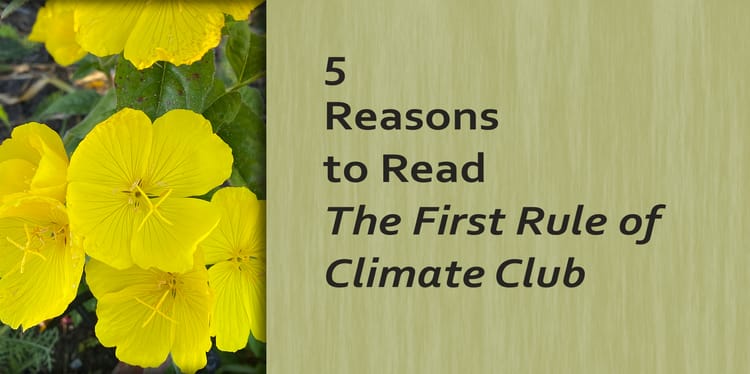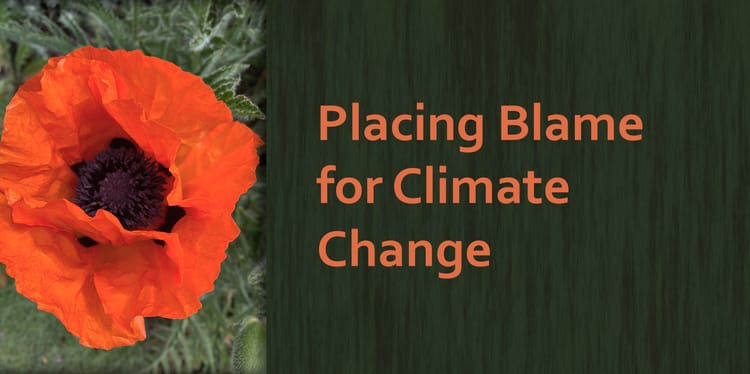Climate Change Fun?

Book Review: Love in the time of Climate Change by Brian Adams
Green Writers Press (2013)

I am reviewing this book precisely because it is not science fiction and not dystopian. It’s a lighthearted romantic comedy, and it’s set in the present. The characters are all everyday people that could live next door, even if the two main male characters act totally sophomoric with their comments about women’s physical attributes. Perhaps, if Adams had written it nine years later, he might have been a bit more sensitive (thinking of Me-Too), but in 2013 he was drawing upon the social awkwardness and immaturity of these characters for laughs.
This was my one main criticism of the book. I almost stopped reading it, and many of you might feel the same at first, but then I wondered if these two men who acted like boys might evolve in the story, so I kept reading. It helped that the protagonist was at times aware enough to realize he was not behaving well. He realized he had a problem, and he does outgrow his crude conduct as the story progresses. The growth of your protagonist, after all, is a fundamental to any great story. This story begins with a character that has a lot of room to develop.
That said, I thought Adams did a great job creating a comedic voice for his main character Casey, a community college professor who is twisted into knots because he can’t date one of his students he is falling in love with. Casey’s hoping that after the semester is over, and she’s no longer a student, he might have a chance. In typical romantic comedy style, Adams throws plenty of obstacles in Casey’s way as he strives to reach that moment when he can ask her out.
It was great to have a breezy read about a serious issue. This is a book that uses the climate crisis as the backdrop for a genre story with a formula that we are all familiar with. We need more books like this, ones to bring the issue to readers of genres that are not typically associated with climate fiction.
The set-up, having a community college science teacher teaching a class about climate change, is perfect for informing readers about a whole variety of climate related problems. For most climate fiction stories an author would not want to go so heavily into these issues, at least not so many of them, but Adams rolls them naturally into his plot line by making each topic he presents revolve around a funny incident or a quirky character or a set-back in his quest to detect if Casey’s love interest, Samantha, is at all interested in him.
I think any writer thinking about writing climate fiction should read this book, not to emulate Adams' heavy concentration on the issues, but to see all the ingenious ways he wove climate activism and climate solutions into a story line. And writers should also note that Adams didn’t ignore the dread that many feel about the catastrophe awaiting future generations. In fact, he names it OCD, Obsessive Climate Disorder, and it becomes one of Casey’s main flaws (besides his inappropriate comments about women). Adams uses OCD to great effect in his humorous plot twists.
Activism is modeled through Casey’s student group the Climate Changers. As the group tackles different issues, the fun and excitement of doing this kind of work, as well as the inevitable interpersonal conflicts that may arise, help to create tension in the story as well as make it interesting to readers who might never think to embark on some activism themselves. This modeling through story characters is a very effective way to get people moving. As they imagine a fictional character joining a protest against a coal burning power plant or creating a fun skit on how Santa Claus is irate about losing all the ice at the North Pole, light bulbs might go off for the reader later when there’s a call for volunteers at a march or a petition drive. They might decide to take that first step and sign up.
This book is definitely an adult read, with strong language, cannabis use, and an adult focus. There are no graphic sex scenes, but there is that cringeworthy obsession with how a woman looks. Adams could have shown a little more of Samantha’s personality, not just focus on her physical beauty, at the start, but since this is a first-person narrative and Casey’s obsession with female anatomy drives that narrative to begin with, the deeper side of Samantha had to wait till later to come out through Casey’s first-person account. Maybe I would call this book a climate romance for guys. Since data show that women are the most concerned about climate change, we do need books to draw the male reader in.
In the end, I enjoyed the book, and I think many of you may too. You might want to order a copy or see if it is at your library. Since it is summertime, it would make a great beach read, that is if you are not busy doing a beach clean-up! So, maybe after the clean-up…





Member discussion